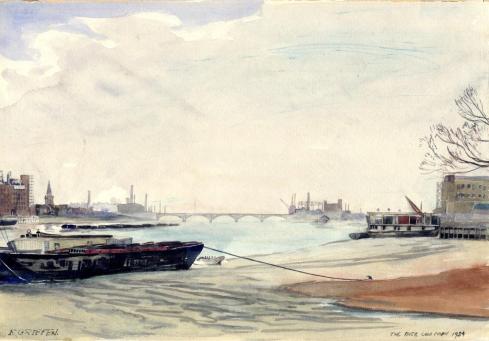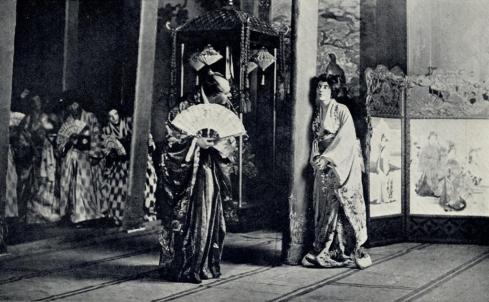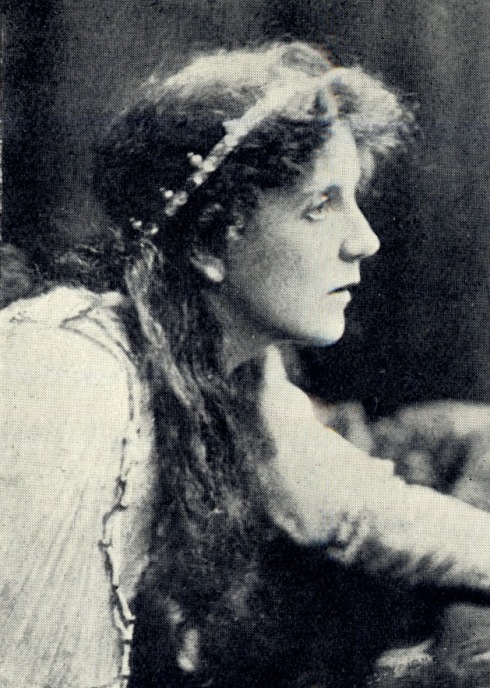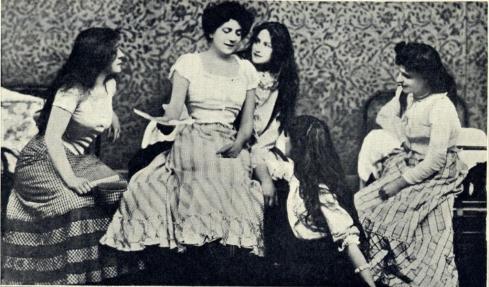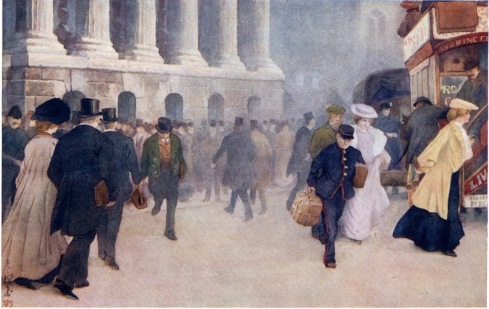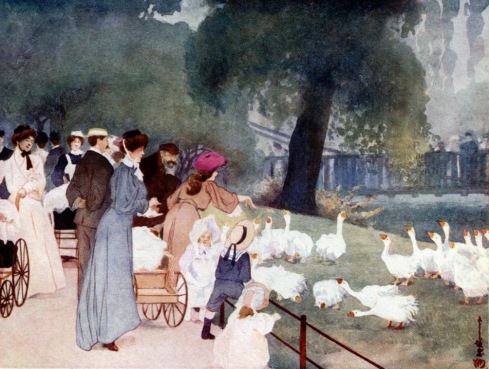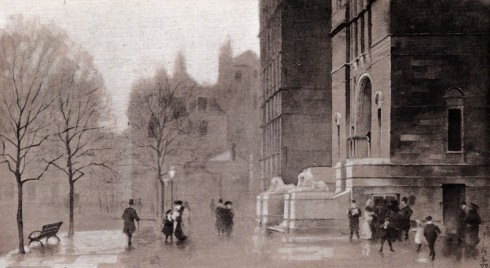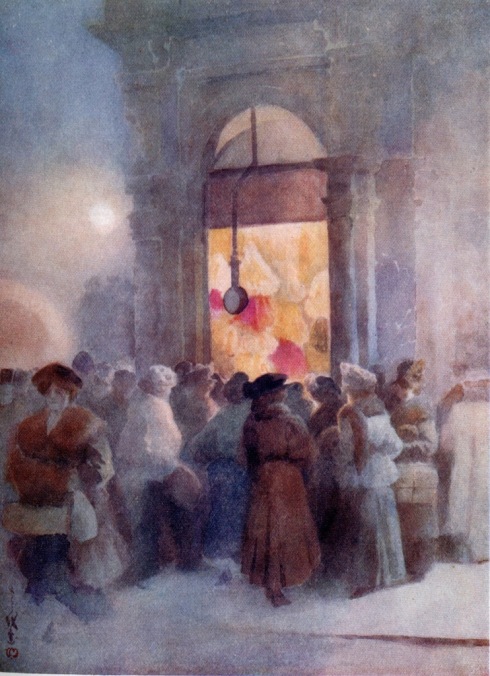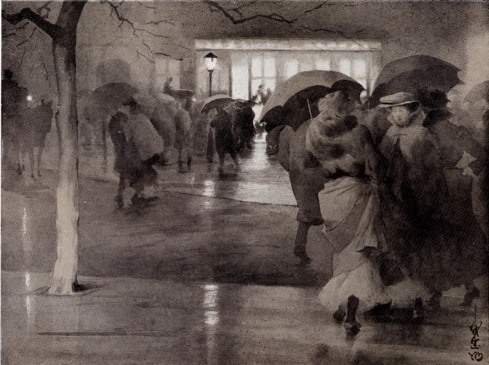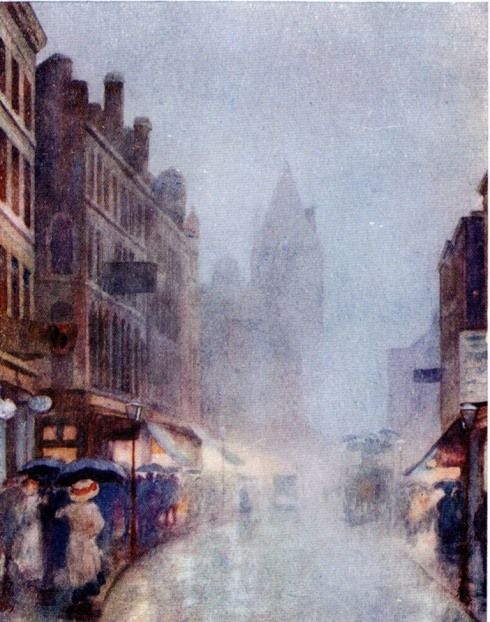The recent Christmas post I did about Yoshio Markino, the Japanese artist who lived in Chelsea, reminded me that there were still some images I hadn’t used in a post, even though I wrote four about him in 2014. I was flicking through Sammy Tsunematsu’s small but exquisite book of Markino pictures when I saw several which cried out to go into a new blog post. Markino is one of those local residents who have become part of a pantheon of characters I’ve written about over the last few years, like Marianne Rush, Margaret Morris, Mortimer Menpes, Dr Phene, Edward Lynley Sambourne and many others. It’s good to welcome back a familiar face from the bohemian art scene of early twentieth century London. And for anyone who wasn’t reading the blog in 2014 it’s an introduction to a fascinating artist.
This is a typical Markino picture – a little bit of darkness, an indistinct view of distant trees and a spire, a lot of water, with a glimpse of a figure almost off the edge, possibly a woman being rowed along the Serpentine. Markino loved London (“I am in mad love of London”) but he saw it as exotic, a mysterious place full of unfamiliar sights and people.
The porters and traders at Covent Garden were just as enigmatic for Markino as any of the London women he admired.
Markino wasn’t just interested in the middle class women he saw coming in and out of theatres, waiting for trains or walking in parks, but also the working class women such as those in this view of Petticoat Lane. The central figure, an old woman examining some cloth, and the sharp eyed man strolling through the crowd are well observed but I think Markino was just as interested, or possibly more interested in the woman on the left, seen from behind with a mass of blonde hair, wrapped up in baggy clothes, her red haired daughter beside her. The most significant action is on the edge of the picture just as in the Covent Garden picture where the two men with mustaches on the right appear to be in close conversation.
One of his rare interiors:
Westminster Abbey. From a lonely vantage point he observes a group of visitors. Departing I think into a gloomy afternoon.
Markino liked the darkening days of autumn and winter.
Late on an autumn afternoon, a flower girl offering a small bouquet to a pair of elegant but indifferent ladies
The street light s are on again here in one of his favourite spots with more crowds of grey men and colourful women.
Those women take the centre of the picture in this picture of a crowd outside some shops.
As evening drew in Markino would wander the night streets, along with many others.
Early evening at a hotel entrance in Knightsbridge,….
…..or outside Buckingham Palace..
…..or at the Constitution Arch near Hyde Park.
Bright lights cut through the gloom in the theatre district.
Markino’s friend Arthur Ransome wrote in his book Bohemia in London “The only man I knew in Chelsea was a Japanese artist who had been my friend in even earlier days when both he and I had been too poor to buy tobacco..”
….. “there is something gypsyish about coffee stalls, something very delightful…I have often bought a cup of coffee in the morning hours to drink on the paupers’ bench along the railings…that was a joyous night when for the first time the keeper of the stall recognized my face and honoured me with talk as a regular customer. ..I used to spend a happy twenty minutes among the loafers by the stall.”
“The safety in the midnight. Wherever in this world is such a safe town like London? You can walk anywhere in London at any time in night. You need not have any fear at all. This is awfully convenient to me to study the night effect.”
Walking home he observes a set of posters on the ragged end of a building, rising above a wooden hoarding. Once again at the edge of the scene a crowd shuffles into the night.
Back in his lodgings Markino works on another autumn view.
Kensington Gardens, unadorned by any figures. Markino remained “in mad love” of London until he finally left it in 1942. But in San Francisco, London, Paris, Rome or Japan he remained, in his own words:
“I am simple Yoshio Markino, quite alone in this world.”
Postscript
My apologies for the late launch of this post, especially to those who usually read the blog on a Thursday morning. I’m sure some of you will be thinking how could a post on Markino take him more time than usual? Isn’t it just a matter of a few pictures and some text featuring mist, overcast weather, dark smoky streets with dim lights and Edwardian women showing a flash of white petticoats? Well, I guess it is in a way, but nevertheless I think it was worth coming back to Markino. I’ve done a lot on book illustrators in the last year or so and he belongs in that Golden Age group, as one of the best of them.
Quotations from Alone in this world: selected essays and A Japanese artist in London by Yoshio Markino and Bohemia in London by Arthur Ransome.


























